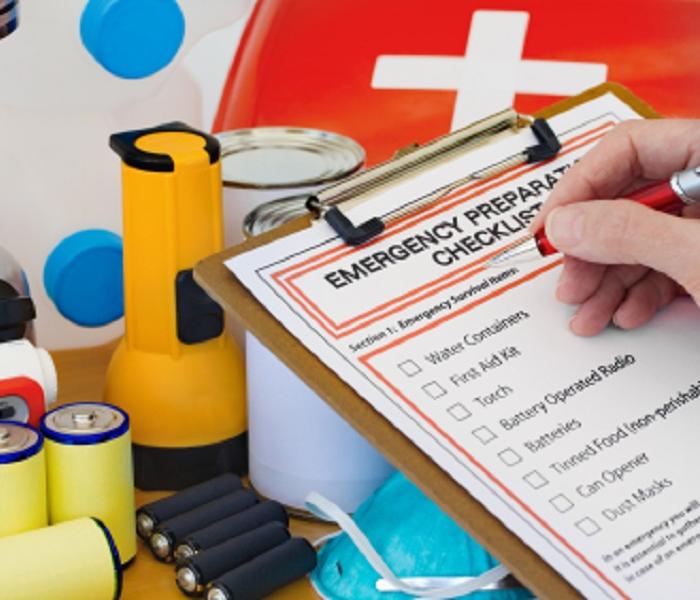Be Ready, National Preparedness Month is Here! Series Part 2 - Gather Emergency Supplies
9/9/2014 (Permalink)
September 2014 marks the eleventh annual National Preparedness Month, sponsored by the Federal Emergency Management Agency in the US Department of Homeland Security. One goal of Homeland Security is to educate the public about how to prepare for emergencies, including natural disasters, mass casualties, biological and chemical threats, radiation emergencies, and terrorist attacks.
If a disaster strikes your community, you might not have access to food, water, or electricity for some time. Take steps now to put together an emergency supply kit so that you will be prepared in case something happens. You should have emergency kits for your home, office, school, and vehicle. You never know where you will be during an emergency.
Emergency Supply Kit
TIPS
- Consider storing two weeks worth of food supplies. You may be able to use many of the canned goods and dry mixes already in your cupboard.
- Store at least a 3-day supply of water for each member of your family – that means 1 gallon per person per day.
- Don’t forget about pets; they’ll need food and water too.
- Learn where your gas, electric, and water shut-off locations are and how to turn them off.
An emergency supply kit is a collection of basic items that you might need during an emergency. It's good to involve whoever is going to use the kit, including children, in assembling it.
Assemble the following items to create kits to use at your home, office, and school and/or in a vehicle:
- Water—one gallon per person, per day
- Food—nonperishable, easy-to-prepare items
- Flashlight
- Battery powered or hand crank radio (NOAA Weather Radio, if possible)
- Extra batteries
- First aid kit
- Medications (7-day supply), other medical supplies, and medical paperwork (e.g., medication list and pertinent medical information)
- Multipurpose tool (e.g., Swiss army knife)
- Sanitation and personal hygiene items
- Copies of personal documents (e.g., proof of address, deed/lease to home, passports, birth certificates, and insurance policies)
- Cell phone with chargers
- Family and emergency contact information
- Extra cash
- Emergency blanket
- Map(s) of the area
- Extra set of car keys and house keys
- Manual can opener
Special Needs
You may need some additional supplies to meet the needs of all family members, such as children, pets, and those with special medical requirements. Suggested items to help meet additional needs are:
- Medical supplies (e.g., hearing aids with extra batteries, glasses, contact lenses, syringes, or a cane)
- Baby supplies (e.g., bottles, formula, baby food, and diapers)
- Games and activities for children
- Pet supplies (see expanded list below)
Once you’ve gathered your supplies, pack the items in easy-to-carry containers, clearly label the containers, and store them where they are easily accessible. In a disaster situation, you may need access to your emergency supply kit quickly - whether you are sheltering at home or evacuating. Make sure to check expiration dates on food, water, and batteries throughout the year.
Involving Children
Involving children is the first step in helping them know what to do in an emergency. There are many ways children can help.
- Ask them to think of items that they would like to include in an emergency supply kit, such as books or games or nonperishable food items. Ask them to help you remember to keep the kits updated.
- Children can help mark the dates on a calendar for checking emergency supplies. Remember to rotate or replace emergency food and water every six months and replace batteries as necessary.
- Children can also help prepare plans and disaster kits for family pets.
Disaster Supply Checklist for Pets
- Food and water for at least 3 days for each pet; bowls, and a manual can opener.
- Depending on the pet you may need a litter box, paper towels, plastic trash bags, grooming items, and/or household bleach.
- Medications and medical records stored in a waterproof container.
- First aid kit with a pet first aid book.
- Sturdy leash, harness, and carrier to transport pet safely. A carrier should be large enough for the animal to stand comfortably, turn around, and lie down. Your pet may have to stay in the carrier for several hours.
- Pet toys and the pet's bed, if you can easily take it, to reduce stress.
- Current photos and descriptions of your pets to help others identify them in case you and your pets become separated, and to prove that they are yours.
- Information on feeding schedules, medical conditions, behavior problems, and the name and telephone number of your veterinarian in case you have to board your pets or place them in foster care.




 24/7 Emergency Service
24/7 Emergency Service
